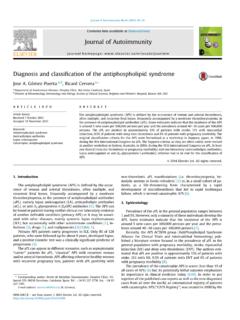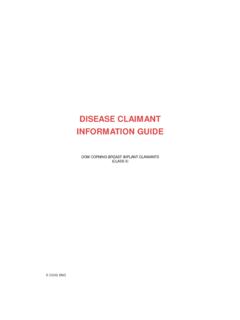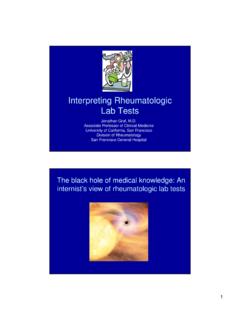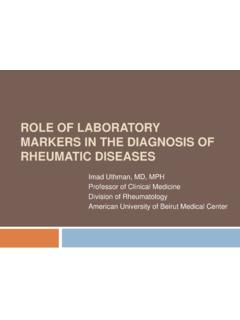Transcription of EYE CHANGES IN LUPUS AND SJOGREN’S …
1 Eye Manifestations of LUPUS And sjogren s syndrome Based on a presentation by Dr. N. Kevin Wade at the BC LUPUS Society Symposium held October 22, 2005. Background Dr. Wade completed his MD in 1998 at McGill University and his Internal Medicine Residency and subsequent Ophthalmology Residency at UBC in 1996. He obtained three years of further fellowship training in Uveitis and Neuro-ophthalmology in Montreal, San Francisco, and Vancouver. He has been practicing ophthalmology for the past 7 years and is on staff at Vancouver General Hospital. His current practice focus is cataract and general ophthalmology.
2 Overview of Eye Diseases in LUPUS and sjogren s syndrome Dr. Wade provided a broad an overview of the anatomy of the eye, and some of the conditions that can be present as a result of dry eyes, LUPUS and Sjogrens syndrome , including: Inflammation of the arteries in the eye; Iritis, which occurs with inflammation of the inner linings of the eye; Cataract, which can occur as a result of inflammation in the eye, aging, and steroid therapy among others. Vitritis is where the jelly like substance behind the lens of the eye is inflamed; Diffuse uveitis refers to more than one level of the eye being inflamed when the eye is considered in terms of front, middle, and back; Periphlebitis, which involves inflammation above the veins in the eye; Scleritis, which is an inflammation of the white coat of the eye; Keratitis, which an inflammation of the cornea, can be very painful but is less likely in LUPUS Optic nerve inflammation.
3 Most often the nerve may be involved by a stroke of the small blood vessels supplying the nerve this is referred to as an ischemic optic neuropathy. Rarely optic neuritis is a primary inflammation of the nerve occurring in LUPUS or sjogren s. Dr Wade then elaborated on a few specific eye problems with LUPUS or sjogren s syndrome : Scleritis - Scleritis is the most frequent serious eye disorder found in LUPUS patients. Cataract is probably the most frequent cause of vision loss but not the most serious as it is easily remedied with surgery. Scleritis is generally visible when it involves the front of the eye.
4 Scleritis is very painful and can cause permanent eye damage. It is possible that there will be ocular bruising around the eye in acute cases. When there is a severe inflammation of the eye, the tissue weakens as it heals. As a result, the eye is prone to future injury from the tissue loss. Rarely, the weakness in the wall of the eye can lead to loss of the eye. Retinal vasculitis Retinal vasculitis can cause serious damage to the retina, and is generally screened for regularly because of the possibility that it can develop in LUPUS . Retinal arteries can be infarcted (a clot causing a stroke of the retina) due to inflammation.
5 Retinal damage will affect the field of vision and if it occurs in the center of the retina then central vision may be lost. This can lead to thrombosis in the blood vessels, which causes blockage and damage. Choroiditis (inflammation of the layer immediately behind the retina) can occur with loss of vision. Occasionally photographs of the back of the eye need to be taken with a dye injection in the arm (fluorescein angiography). This can show loss of blood flow in the choroidal layer which may be otherwise hard to see in the eye doctor s office. Plaquenil toxicity - Drug treatment, in particular hydroxychloroquine or Plaquenil can cause pigmented deposits in the cornea and retina.
6 This is more common with higher doses (more than 200 mg/day) and longer treatments times. There may be a ring of pigment which can cause loss of visual field. It is important to have yearly eye exams for toxicity if you are on Plaquenil. These eye exams should include colour vision testing, looking at a grid in the center of your vision, dilation of the pupil to see into the back of the eye, and central 10 degree visual fields. Glaucoma screening fields (usually 24 or 30 degrees in radius) are not sufficient to screen for Plaquenil damage. Cataracts Steroid therapy can cause cataracts.
7 People usually notice glare which progresses to blurry vision. It may seem as if your glasses are not working properly. Night vision may also be reduced. The first sign of glare is difficulty driving into the sunset or difficulty with reflections from headlights on rainy nights. Anterior Ischemic Optic Neuropathy This may result from a stroke to the optic nerve it can occur in the front (anterior) or deeper (posterior) in the nerve as it leaves the back of the eye. Often the upper or lower half of vision is lost in that eye. High blood pressure High blood pressure can cause significant eye damage as a result of its short and long term effects on the optic nerve, retinal blood vessels, and choroidal blood vessels.
8 Because LUPUS may affect the kidney it often results in high blood pressure problems. Occasionally, an eye examination may reveal the first evidence of high blood pressure because of retinal blood vessel and optic nerve CHANGES . Migraines headaches and migraines are more common in people with LUPUS . This may be a result of blood supply problems in the brain particularly in those who have antiphospholipid antibodies (proteins in the blood that may trigger clotting). Dry Eye syndrome Dry eye syndrome is suspected from patient complaints of eye burning often worse later in the day and diagnosed by measuring the tear production on a standardized paper filter strip inserted under the bottom lid of the eye, for five minutes.
9 If tear production is 8 mm or less, the diagnosis of dry eye is confirmed. The most common cause of dry eye in LUPUS and Sjogrens is lacrimal gland inflammation. When the mouth is dry also it is called keratoconjunctivitis sicca. Similar eye symptoms can be caused by meibomitis a plugging of oil secretions in the eyelid glands. Many people have this condition without knowing it. Meibomitis can cause red eyes, burning eyes in the morning and similar symptoms whereas true dry eyes are generally worse in the evenings. In essence, meibomitis occurs as a result of the loss of the normal oily coating in the tears, which prevents evaporation.
10 As a result, tears will evaporate more quickly. Steroid tablets or eye drops may worsen meibomitis. Both dry eyes and meibomitis may be helped by warm wet compresses and artificial tear products such as Refresh Endura (one of the few artificial tear products to contain replacement oils and no preservatives). Issues that may arise as a result of dry eyes include the following: Small erosions in the epithelium (corneal surface lining), which are very painful and may make it difficult to tolerate bright lights. A dry eye is more prone to infection. Inflammation of the lacrimal glands (tear gland) can cause dry eye as a result of accumulation of invading white blood cells.








